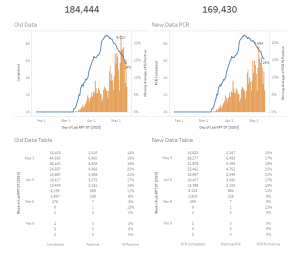Yesterday, The Atlantic put out the story, “How Virginia Juked Its COVID-19 Data: The state is combining results from viral and antibody tests in the same statistic. This threatens to confound America’s understanding of the pandemic.” Among other things, the story reported:
Virginia’s decision to mix the results of two different kinds of tests marks a new low in data standards.
The state is reporting viral tests and antibody tests in the same figure, even though the two types of test answer different questions about the pandemic and reveal different types of information. By combining these two types of test, the state is able to portray itself as having a more robust infrastructure for tracking and containing the coronavirus than it actually does. It can represent gains in testing that do not exist in reality, says Ashish Jha, the K.T. Li Professor of Global Health at Harvard.
Read: There’s one big reason the U.S. economy can’t reopen
“It is terrible. It messes up everything,” Jha told us. He said that combining the test results, as Virginia has done, produces information that is impossible to interpret.
The state’s decision to combine the tests was first reported by the Richmond Times-Dispatch.
It added:
But commonwealth officials say they have no choice. Other states are mixing their results, claimed Clark Mercer, the chief of staff to Governor Ralph Northam, at a press conference this week.
“You can’t win” by keeping viral and antibody findings separate in public data, he said, adding that combining the two tests’ results was the only way to improve Virginia’s position in a list of states ranked by the number of tests they had conducted per capita. “If another state is including serological tests, and they’re ranked above Virginia, and we are not, and we’re getting criticized for that, [then], hey, you can’t win either way. Now we are including them, and our ranking will be better, and we’re being criticized,” he said.
In response, the Virginia Department of Health just put out the following statement, stating:
- “Antibody tests make up less than nine percent of overall tests. When these tests are removed from total results, there is minimal change in the percent positive of tests and no difference in overall trends.”
- “In the past three weeks the number of antibody tests being utilized has increased in Virginia. Due to this change, going forward the Virginia Department of Health will provide a breakdown of the COVID-19 test data by all test types and by only PCR tests.”
VIRGINIA DEPARTMENT OF HEALTH RELEASES DISAGGREGATED TESTING DATA; NO DIFFERENCES IN TRENDS
FOR IMMEDIATE RELEASE – May 14, 2020
For More Information Contact: Maria Reppas, VDH Communications Director, maria.reppas@vdh.virginia.gov
Virginia Department of Health Releases Disaggregated Testing Data; No Differences in Trends
(RICHMOND, Va.) — The Virginia Department of Health today released testing data broken out by PCR (diagnostic) and antibody (serology) tests. Antibody tests make up less than nine percent of overall tests. When these tests are removed from total results, there is minimal change in the percent positive of tests and no difference in overall trends.
The Virginia Department of Health defines a case as confirmed when there is a positive PCR test. A goal in monitoring the number of testing encounters and the percent of COVID-19 tests that are positive is to gauge the capacity of the healthcare system to perform COVID-19 testing. In the past three weeks the number of antibody tests being utilized has increased in Virginia. Due to this change, going forward the Virginia Department of Health will provide a breakdown of the COVID-19 test data by all test types and by only PCR tests.




 Sign up for the Blue Virginia weekly newsletter
Sign up for the Blue Virginia weekly newsletter![Thursday News: “World leaders now enter the White House at their own risk”; “2 Israeli Embassy staff shot and killed in front of Capital Jewish Museum in DC”; GOP Moves to Pass “Monstrous” Bill Which “steal[s] from the poor and give[s] to the rich”](https://bluevirginia.us/wp-content/uploads/2025/05/montage0522-238x178.jpg)





![Ivy Main: “One state that will lose big under Trump’s order [stopping approvals, permits and funding for wind projects] is Virginia, which has positioned itself to be a national leader in offshore wind deployment, supply chain and manufacturing.”](https://bluevirginia.us/wp-content/uploads/2025/05/offshorewindposter-100x75.jpg)

